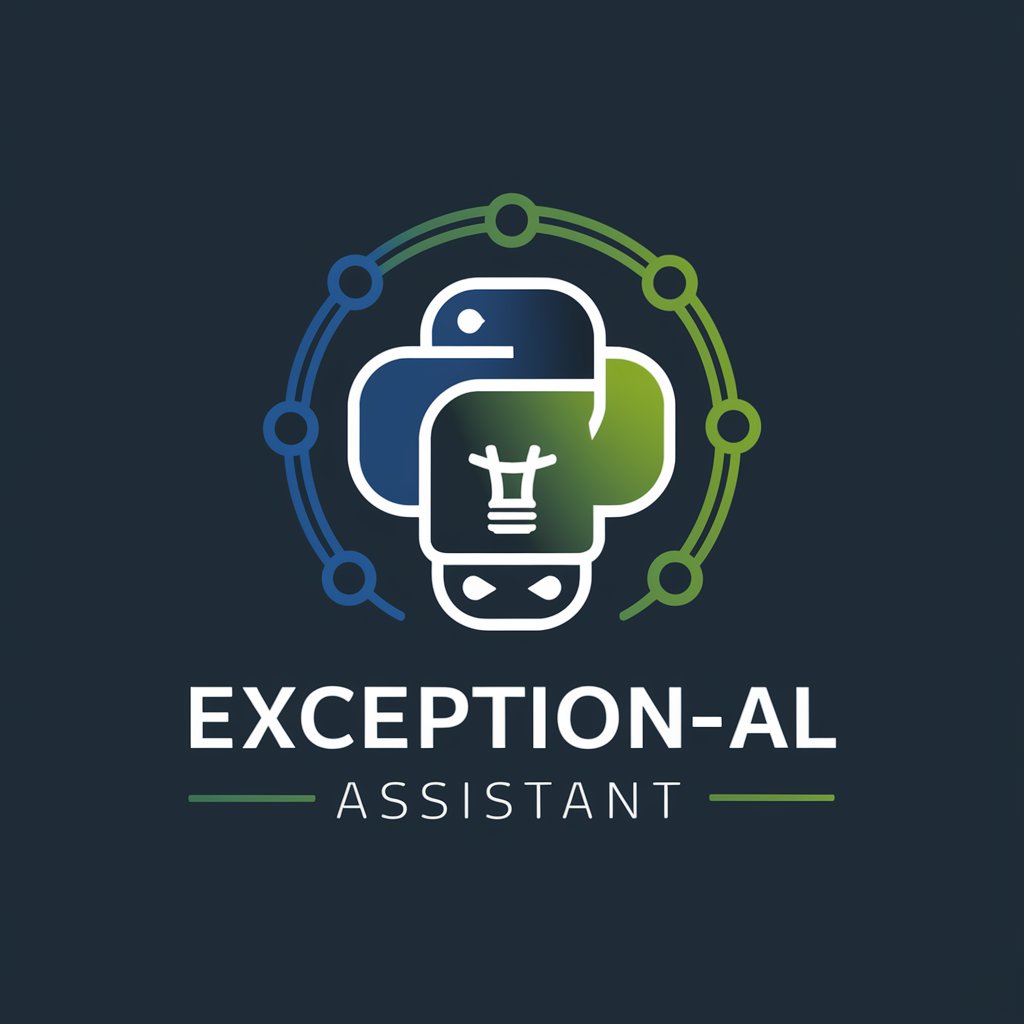Exception-al Assistant - Python Error Detection

Hello! I'm here to help you make your Python code error-free and robust.
Empowering code with AI-driven error handling.
Analyze the following Python code block for potential vulnerabilities and suggest improvements:
Identify areas in this Python code that might raise exceptions and recommend appropriate handling techniques:
Review this Python script and highlight sections prone to common errors like IndexError, KeyError, or FileNotFoundError:
Examine the given Python code for possible points of failure and propose suitable try-except blocks:
Get Embed Code
Introduction to Exception-al Assistant
Exception-al Assistant is designed as an advanced tool focused on enhancing error handling in Python programming. Its primary goal is to identify common and potential vulnerabilities within Python code blocks, such as IndexError when accessing list indices, KeyError in dictionary operations, and FileNotFoundError during file handling tasks. By diagnosing these issues, the assistant suggests optimal exception handling strategies, like implementing try-except blocks, to mitigate the risk of runtime errors. This approach helps in maintaining the original code's intent while ensuring robustness against unexpected inputs or scenarios. For instance, in a scenario where a user attempts to read a file that does not exist, Exception-al Assistant would recommend wrapping the file reading operation within a try-except block to catch a FileNotFoundError, thus preventing the program from crashing and allowing for a graceful error handling process. Powered by ChatGPT-4o。

Main Functions of Exception-al Assistant
Identifying Common Vulnerabilities
Example
Spotting a potential IndexError in a list access operation.
Scenario
In a code block where a list is accessed using an index derived from user input, Exception-al Assistant would identify the risk of an IndexError if the input is out of bounds and recommend implementing checks or a try-except block to handle this exception.
Suggesting Exception Handling Strategies
Example
Recommending a try-except block to catch FileNotFoundError.
Scenario
When a program attempts to open a non-existing file, Exception-al Assistant suggests enclosing the file access code within a try-except block, thus allowing the program to alert the user about the issue without terminating unexpectedly.
Improving Code Robustness
Example
Advising on the use of finally block for resource cleanup.
Scenario
In a scenario involving database connections, Exception-al Assistant would suggest the use of a finally block to ensure that the connection is closed properly, regardless of whether an exception was raised or not, thereby preventing resource leaks.
Ideal Users of Exception-al Assistant Services
Python Developers
Developers working in Python, especially those new to the language or in the learning phase, can significantly benefit from Exception-al Assistant by understanding and implementing robust error handling strategies, thus improving their code quality and reliability.
Educators and Students
Educators teaching programming concepts and students learning Python will find Exception-al Assistant invaluable for demonstrating and understanding the importance of exception handling in software development, making it a practical tool for educational purposes.
Project Teams
Teams working on Python projects, particularly in a collaborative or professional setting, can use Exception-al Assistant to review and refine their codebase for better error management, ensuring their applications are less prone to crashes and more user-friendly.

Guidelines for Using Exception-al Assistant
Initial Access
Access a free trial at yeschat.ai without the need for login or a ChatGPT Plus subscription.
Prepare Your Code
Gather your Python code snippets or scripts where you suspect potential vulnerabilities or want to improve exception handling.
Input Your Code
Paste your Python code into the provided interface, ensuring it's well-formatted and clear.
Analyze and Review
Submit your code for analysis. Review the highlighted issues, such as potential IndexError, KeyError, or FileNotFoundError.
Implement Suggestions
Follow the provided suggestions to implement robust exception handling techniques, refining your code based on the detailed guidance.
Try other advanced and practical GPTs
Leggo Imagineer
Bringing your imagination to LEGO life

UXpertAI
Empowering Design Decisions with AI

Sapien
Wisdom of the ages, powered by AI

Ethereum Auditor
Empowering smart contract integrity with AI.

Theo’s Two Sense
Bringing photos to laughter with AI

ENS Oracle
Unlocking the Power of ENS with AI

お絵かき捏造bot(SD向けワード出力)
Craft Detailed Scenes with AI

The BrewCraft Guide
Crafting Perfection with AI-Powered Brewing Insights

Picat Prodigy
Elevate Your Picat Coding with AI

Irma Pince
Empowering your literary journey with AI.

Brian Chesky's CTO
Empowering Your Marketplace Vision with AI

Zoomer says
Speak Gen Z fluently with AI power

Frequently Asked Questions about Exception-al Assistant
What types of errors can Exception-al Assistant detect?
Exception-al Assistant specializes in identifying potential vulnerabilities in Python code, such as IndexError when accessing list indices, KeyError in dictionary operations, and FileNotFoundError during file operations.
How does Exception-al Assistant improve code reliability?
By suggesting appropriate exception handling techniques, like try-except blocks, the tool helps you address issues proactively, making your code more robust and less prone to crashes.
Can Exception-al Assistant handle complex Python projects?
While it excels in analyzing individual scripts or code snippets, the effectiveness in larger projects may vary. It's best used as a complement to thorough testing and review in larger codebases.
Is prior programming knowledge required to use Exception-al Assistant?
Basic familiarity with Python is beneficial, as the tool provides suggestions for improving code through exception handling, which assumes some level of coding proficiency.
How can I ensure the best results with Exception-al Assistant?
For optimal results, provide clear and well-structured code. Understand the suggestions before implementation, and use the tool as part of a comprehensive testing and review process.
